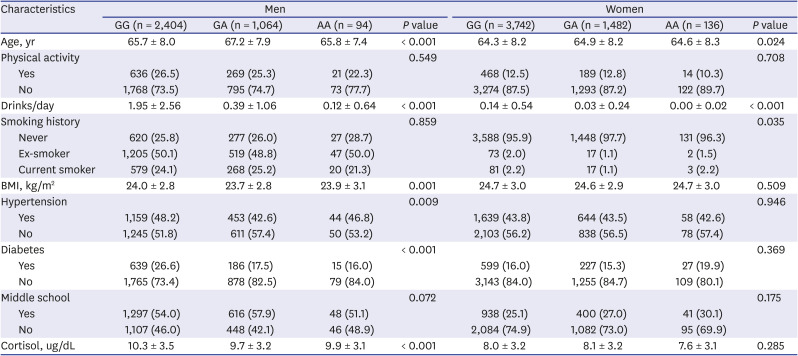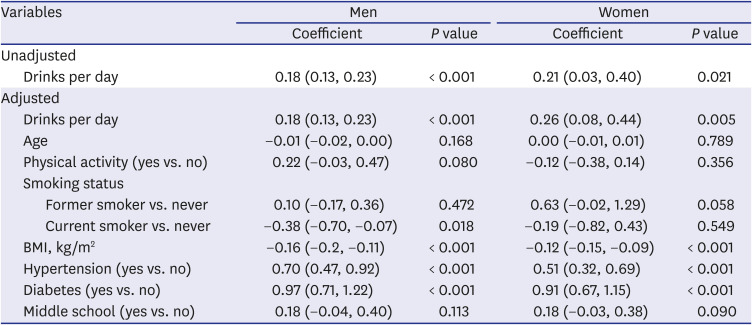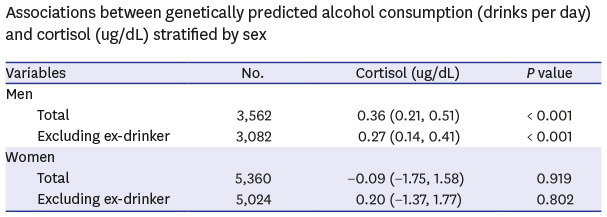1. Herman JP, McKlveen JM, Ghosal S, Kopp B, Wulsin A, Makinson R, et al. Regulation of the hypothalamic-pituitary-adrenocortical stress response. Compr Physiol. 2016; 6(2):603–621. PMID:
27065163.

2. Badrick E, Bobak M, Britton A, Kirschbaum C, Marmot M, Kumari M. The relationship between alcohol consumption and cortisol secretion in an aging cohort. J Clin Endocrinol Metab. 2008; 93(3):750–757. PMID:
18073316.

3. de Wit M, Wiaterek GK, Gray ND, Goulet KE, Best AM, Clore JN, et al. Relationship between alcohol use disorders, cortisol concentrations, and cytokine levels in patients with sepsis. Crit Care. 2010; 14(6):R230. PMID:
21176217.

4. London S, Willett W, Longcope C, McKinlay S. Alcohol and other dietary factors in relation to serum hormone concentrations in women at climacteric. Am J Clin Nutr. 1991; 53(1):166–171. PMID:
1845789.

5. Thayer JF, Hall M, Sollers JJ 3rd, Fischer JE. Alcohol use, urinary cortisol, and heart rate variability in apparently healthy men: evidence for impaired inhibitory control of the HPA axis in heavy drinkers. Int J Psychophysiol. 2006; 59(3):244–250. PMID:
16325293.

6. Orio L, Antón M, Rodríguez-Rojo IC, Correas Á, García-Bueno B, Corral M, et al. Young alcohol binge drinkers have elevated blood endotoxin, peripheral inflammation and low cortisol levels: neuropsychological correlations in women. Addict Biol. 2018; 23(5):1130–1144. PMID:
28840951.

7. Steptoe A, Wardle J, Lipsey Z, Mills R, Oliver G, Jarvis M, et al. A longitudinal study of work load and variations in psychological well-being, cortisol, smoking, and alcohol consumption. Ann Behav Med. 1998; 20(2):84–91. PMID:
9989313.

8. Naimi TS, Brown DW, Brewer RD, Giles WH, Mensah G, Serdula MK, et al. Cardiovascular risk factors and confounders among nondrinking and moderate-drinking U.S. adults. Am J Prev Med. 2005; 28(4):369–373. PMID:
15831343.

9. Smith GD, Ebrahim S. Mendelian randomization: prospects, potentials, and limitations. Int J Epidemiol. 2004; 33(1):30–42. PMID:
15075143.

10. Didelez V, Sheehan N. Mendelian randomization as an instrumental variable approach to causal inference. Stat Methods Med Res. 2007; 16(4):309–330. PMID:
17715159.

11. Castle WE. Mendel's law of heredity. Science. 1903; 18(456):396–406. PMID:
17752783.

12. Greenland S. An introduction to instrumental variables for epidemiologists. Int J Epidemiol. 2000; 29(4):722–729. PMID:
10922351.

13. Davies NM, Holmes MV, Davey Smith G. Reading Mendelian randomisation studies: a guide, glossary, and checklist for clinicians. BMJ. 2018; 362:k601. PMID:
30002074.

14. Jeon C, Lee JY, Lee SJ, Jung KJ, Kimm H, Jee SH. Bilirubin and risk of ischemic heart disease in Korea: a two-sample Mendelian randomization study. Epidemiol Health. 2019; 41:e2019034. PMID:
31319653.

15. Yasue H, Mizuno Y, Harada E. Association of East Asian variant aldehyde dehydrogenase 2 genotype (ALDH2*2*) with coronary spasm and acute myocardial infarction. Adv Exp Med Biol. 2019; 1193:121–134. PMID:
31368101.

16. Huang YH, Chang KH, Lee YS, Chen CM, Chen YC. Association of alcohol dehydrogenase and aldehyde dehydrogenase polymorphism with spontaneous deep intracerebral haemorrhage in the Taiwan population. Sci Rep. 2020; 10(1):3641. PMID:
32107439.

17. Yang S, Lee J, Choi IJ, Kim YW, Ryu KW, Sung J, et al. Effects of alcohol consumption, ALDH2 rs671 polymorphism, and Helicobacter pylori infection on the gastric cancer risk in a Korean population. Oncotarget. 2017; 8(4):6630–6641. PMID:
28036260.

18. He L, Deng T, Luo H. Aldehyde dehydrogenase 2 (ALDH2) polymorphism and the risk of alcoholic liver cirrhosis among East Asians: a meta-analysis. Yonsei Med J. 2016; 57(4):879–884. PMID:
27189280.

19. Takagi S, Baba S, Iwai N, Fukuda M, Katsuya T, Higaki J, et al. The aldehyde dehydrogenase 2 gene is a risk factor for hypertension in Japanese but does not alter the sensitivity to pressor effects of alcohol: the Suita study. Hypertens Res. 2001; 24(4):365–370. PMID:
11510748.

20. Kweon SS, Shin MH, Jeong SK, Nam HS, Lee YH, Park KS, et al. Cohort profile: the Namwon Study and the Dong-gu Study. Int J Epidemiol. 2014; 43(2):558–567. PMID:
23505254.

21. Kim HY, Choi CK, Kweon SS, Lee YH, Nam HS, Park KS, et al. Effect modification of acetaldehyde dehydrogenase 2 rs671 polymorphism on the association between alcohol intake and blood pressure: the Dong-gu Study. J Korean Med Sci. 2020; 35(9):e14. PMID:
32141245.

22. Chung W, Lim S, Lee S. Why is high-risk drinking more prevalent among men than women? Evidence from South Korea. BMC Public Health. 2012; 12(1):101. PMID:
22304965.

23. Millwood IY, Walters RG, Mei XW, Guo Y, Yang L, Bian Z, et al. Conventional and genetic evidence on alcohol and vascular disease aetiology: a prospective study of 500 000 men and women in China. Lancet. 2019; 393(10183):1831–1842. PMID:
30955975.
24. Stock JH, Wright JH, Yogo M. A survey of weak instruments and weak identification in generalized method of moments. J Bus Econ Stat. 2002; 20(4):518–529.

25. Wehby GL, Ohsfeldt RL, Murray JC. ‘Mendelian randomization’ equals instrumental variable analysis with genetic instruments. Stat Med. 2008; 27(15):2745–2749. PMID:
18344186.

26. Burgess S, Thompson SG. Bias in causal estimates from Mendelian randomization studies with weak instruments. Stat Med. 2011; 30(11):1312–1323. PMID:
21432888.

27. Burgess S, Thompson SG. CRP CHD Genetics Collaboration. Avoiding bias from weak instruments in Mendelian randomization studies. Int J Epidemiol. 2011; 40(3):755–764. PMID:
21414999.

28. Blaine SK, Milivojevic V, Fox H, Sinha R. Alcohol effects on stress pathways: impact on craving and relapse risk. Can J Psychiatry. 2016; 61(3):145–153. PMID:
27254089.
29. Ogilvie KM, Lee S, Rivier C. Divergence in the expression of molecular markers of neuronal activation in the parvocellular paraventricular nucleus of the hypothalamus evoked by alcohol administration via different routes. J Neurosci. 1998; 18(11):4344–4352. PMID:
9592111.

30. Li Z, Kang SS, Lee S, Rivier C. Effect of ethanol on the regulation of corticotropin-releasing factor (CRF) gene expression. Mol Cell Neurosci. 2005; 29(3):345–354. PMID:
15914027.

31. Fukuda S, Morimoto K. Lifestyle, stress and cortisol response: Review II : Lifestyle. Environ Health Prev Med. 2001; 6(1):15–21. PMID:
21432232.
32. Spencer RL, Hutchison KE. Alcohol, aging, and the stress response. Alcohol Res Health. 1999; 23(4):272–283. PMID:
10890824.
33. Richardson HN, Lee SY, O'Dell LE, Koob GF, Rivier CL. Alcohol self-administration acutely stimulates the hypothalamic-pituitary-adrenal axis, but alcohol dependence leads to a dampened neuroendocrine state. Eur J Neurosci. 2008; 28(8):1641–1653. PMID:
18979677.

34. Sinha R, Fox HC, Hong KI, Hansen J, Tuit K, Kreek MJ. Effects of adrenal sensitivity, stress- and cue-induced craving, and anxiety on subsequent alcohol relapse and treatment outcomes. Arch Gen Psychiatry. 2011; 68(9):942–952. PMID:
21536969.

35. Groote Veldman R, Meinders AE. On the mechanism of alcohol-induced pseudo-Cushing's syndrome. Endocr Rev. 1996; 17(3):262–268. PMID:
8771359.

36. Debono M, Ghobadi C, Rostami-Hodjegan A, Huatan H, Campbell MJ, Newell-Price J, et al. Modified-release hydrocortisone to provide circadian cortisol profiles. J Clin Endocrinol Metab. 2009; 94(5):1548–1554. PMID:
19223520.

37. Chan S, Debono M. Replication of cortisol circadian rhythm: new advances in hydrocortisone replacement therapy. Ther Adv Endocrinol Metab. 2010; 1(3):129–138. PMID:
23148157.









 PDF
PDF Citation
Citation Print
Print




 XML Download
XML Download